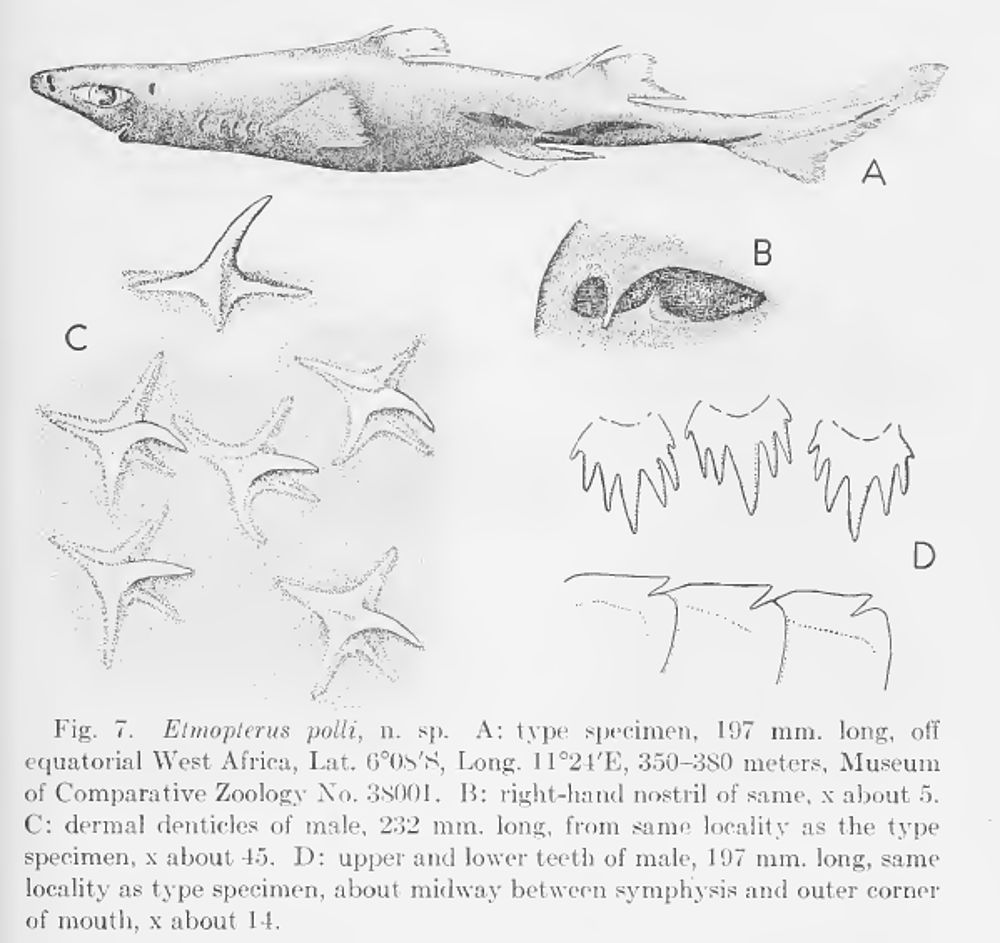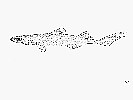Etmopterus polli
Bigelow, Schroeder & Springer, 1953
African lanternshark
Classification: Elasmobranchii Squaliformes Etmopteridae
Reference of the original description
New and little known sharks from the Atlantic and from the Gulf of Mexico. Bulletin of the Museum of Comparative Zoology at Harvard College, 109(3), 213–276
New and little known sharks from the Atlantic and from the Gulf of Mexico. Bulletin of the Museum of Comparative Zoology at Harvard College, 109(3), 213–276
Image of the original description

Etmopterus polli Bigelow, Schroeder& Springer, 1953, © Bigelow et al, 1953

Etmopterus polli Bigelow, Schroeder& Springer, 1953, © Bigelow et al, 1953
Synonyms / new combinations and misspellings
Etmopterus cf. polli
Etmopterus cf. polli
Types
Etmopterus polli
Holotype: MCZ: 38001 Paratype: MCZ: 38000.a MCZ: 38001.b to Garrick (old: 38001) USNM: 163370 (old: MCZ 38001); USNM: 163364 (old: MCZ 38000);
Etmopterus polli
Holotype: MCZ: 38001 Paratype: MCZ: 38000.a MCZ: 38001.b to Garrick (old: 38001) USNM: 163370 (old: MCZ 38001); USNM: 163364 (old: MCZ 38000);
Description :
Citation: Etmopterus polli Bigelow, Schroeder & Springer, 1953: In: Database of modern sharks, rays and chimaeras, www.shark-references.com, World Wide Web electronic publication, Version 01/2026
Please send your images of "Etmopterus polli" to info@shark-references.com

Etmopterus polli Bigelow, Schroeder& Springer, 1953 © Dr. Nicolas Straube, Curator of Ichthyology & Associate Professor, Department of Natural History, University Museum of Bergen

Etmopterus polli Bigelow, Schroeder& Springer, 1953 © Dr. Nicolas Straube, Curator of Ichthyology & Associate Professor, Department of Natural History, University Museum of Bergen
Common names
 Tollo lucero africano,
Tollo lucero africano,  Sagre à menton lisse,
Sagre à menton lisse,  African lantern shark,
African lantern shark,  African lanternshark,
African lanternshark,  Lixinha-da-fundura
Lixinha-da-fundura
 Tollo lucero africano,
Tollo lucero africano,  Sagre à menton lisse,
Sagre à menton lisse,  African lantern shark,
African lantern shark,  African lanternshark,
African lanternshark,  Lixinha-da-fundura
Lixinha-da-fundura
Distribution
Eastern Atlantic: Guinea to Côte d"quot;Ivoire; Nigeria to Angola. Source: www.gbif.org
Eastern Atlantic: Guinea to Côte d"quot;Ivoire; Nigeria to Angola. Source: www.gbif.org
Human uses
fisheries: minor commercial; price category: not marketed/unknown; price reliability:
fisheries: minor commercial; price category: not marketed/unknown; price reliability:
Habitat
bathydemersal; marine; depth range 300 - 1000 m
bathydemersal; marine; depth range 300 - 1000 m
Dentition
Teeth smooth edged, of the usual etmopterid shapes; 29/16-1-16. in type specimen, 27-34/28-30 in other specimens 207-232 mm. long. Upper teeth mostly with 5-7 cusps, the median cusp much the longest, the outermost cusp on each side much the shortest; a few teeth with only 3 cusps. Lower teeth with the cusp directed so strongly outward that the inner cutting edges are practically parallel with the general contour of the jaw; median lower tooth in type but not in ten other specimens examined. Mostly three rows in function simultaneously in upper jaw, one row in lower jaw [2749];
Teeth smooth edged, of the usual etmopterid shapes; 29/16-1-16. in type specimen, 27-34/28-30 in other specimens 207-232 mm. long. Upper teeth mostly with 5-7 cusps, the median cusp much the longest, the outermost cusp on each side much the shortest; a few teeth with only 3 cusps. Lower teeth with the cusp directed so strongly outward that the inner cutting edges are practically parallel with the general contour of the jaw; median lower tooth in type but not in ten other specimens examined. Mostly three rows in function simultaneously in upper jaw, one row in lower jaw [2749];
Remarks
shark-references Species-ID=2181;
shark-references Species-ID=2181;

















